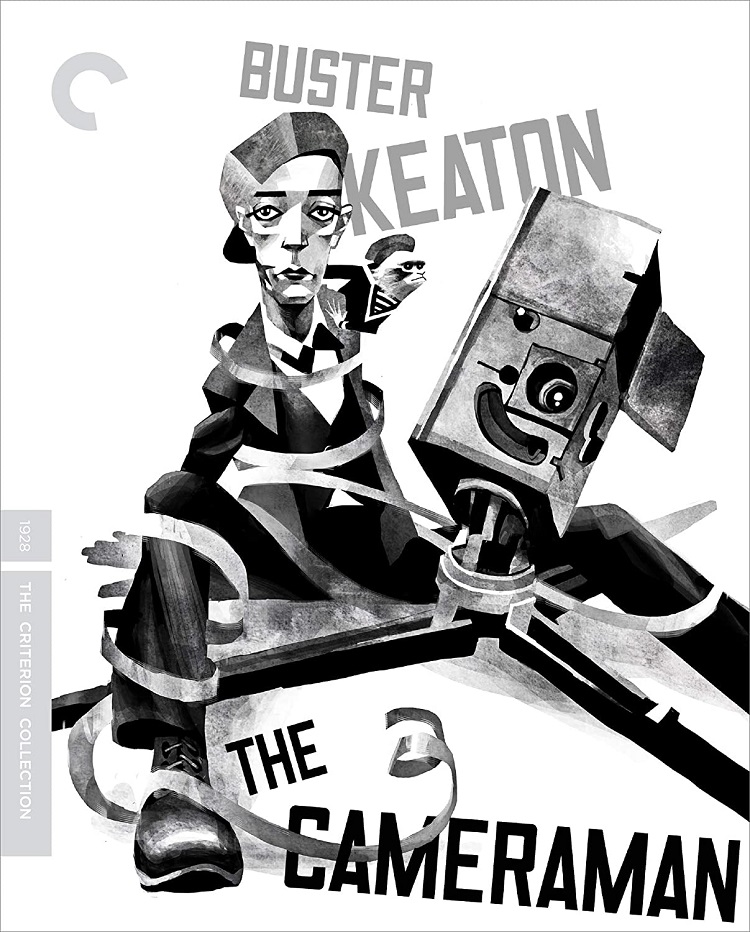
Although a talented filmmaker, Buster Keaton wasn’t a great business man and his box-office struggles caused him to sign on with Metro-Goldwyn-Mayer. The Cameraman was his first film in his deal with MGM, a decision he’s on record as calling “the worst mistake of my life,” the title of a chapter from his autobiography, which is included in the accompanying booklet. Although the studio began to exert control over him and his work, he was still able to turn out an amusing picture.
Buster is a tintype photographer and falls in love at the sight of Sally (Marceline Day). Upon learning she works for MGM newsreels, he buys a used camera and tries to shoot news but his footage is terrible. Sally takes his phone number and when she calls him for an afternoon, the audience sees him race down three flights of stairs as the camera drops. He constantly fights to be near her. There’s a great bus gag as he is swept away by a group of riders. They go to a public pool and almost every man wants her attention. Heading home, they are given a lift by MGM cameraman Harold (Harold Goodwin), who also has an interest in Sally.
She gives Buster a tip about a Chinatown celebration taking place and he, along with a new friend/assistant (a monkey), gets caught in a Tong gang war in an elaborate and funny sequence where his life is frequently in danger. After discovering no film in the camera, the boss (Sidney Bracey) doesn’t want to see him again. Embarrassed for himself and the trouble he causes Sally, he leaves. At a boat race, Buster is able to find redemption.
Coming in at 69 minutes, The Cameraman moves at a brisk place. Keaton keeps the gags coming and doesn’t waste scenes in this lighthearted romance.
The video opens with the following text: “This 4K digital restoration of The Cameraman was undertaken by the Criterion Collection, the Cineteca di Bologna, and Warner Bros. The original version of the film, lost since 1951, featured three minutes of footage that do not exist in any surviving film element. For this restoration, three elements were used: a 35 mm MGM second generation fine grain; a 16 mm print from the Library of Congress, courtesy of Bruce Lawton and the Malkames Collection; and a 35 mm duplicate positive from MGM’s Big Parade of Comedy. The 16 mm print was the primary source for the first three reels of the film. The film elements were scanned at Warner Bros. Motion Picture Imaging in Burbank, California, and the digital restoration was performed at 12Immagine Ritrovata in Bologna, Italy.”
The film is displayed at an aspect ratio of 1.37:1. In those first three reels, there are vertical scratches and lines of spots moving across the frame. Whites bloom while blacks and grays are light. When Buster tries to enter the office building, some frames are missing. Title cards are discolored and light bleeds in from sides. When Buster leaves the office building, signals the use of 35 mm elements because the image is cleaner, blacks are richer, whites look natural, the focus is sharper, and the title cards have a more uniform color. Depth is well captured, such as when Buster and the camera ride a fire engine.
Presented in uncompressed audio, the score was composed and conducted by Timothy Brock and preformed by the orchestra of the Teatro Comunale di Bologna and I Virtuosi Italiani. It has a good dynamic range as it conveys the emotions of the scenes and characters.
The Special Features are:
- An audio commentary from 2004 featuring Glenn Mitchell, author of A-Z of Silent Film Comedy: An Illustrated Companion
- Spite Marriage (76 min) was Keaton’s next feature for MGM and his last silent one. It has a synchronized score and sound effects. Elmer (Keaton), a pants presser, is infatuated with an actress Trilby Drew (Dorothy Sebastian). Trilby is infatuated with fellow actor Lionel Benmore (Edward Earle), but he goes after a younger socialite Ethyl Norcrosse (Leila Hyams). Triby is jealous when she finds out Lionel and Ethyl are engaged, so quickly marries Elmer. Worried that the marriage to someone of such low startus will reflect poorly on her, she leaves him, which sends Elmer on a journey dealing with criminals and sailors. The film has been given a new 2K restoration and comes with a 2004 commentary by film historians Jeffrey Vance and John Bengtson.
- So Funny It Hurt: Buster Keaton & MGM (38 min), a 2004 documentary by film historian Kevin Brownlow and filmmaker Christopher Bird about Keaton teaming up with the studio.
- Time Travelers (16 min), a 2020 documentary by Daniel Raim features film historians Bengtson and Marc Wanamaker talking about and taking viewers to the film’s locations.
- James L. Neibaur (14 min), a new interview with the author of The Fall of Buster Keaton: His Films for MGM, Educational Pictures, and Columbia about Keaton’s late career.
- The Motion Picture Camera (33 min), a 1979 documentary by A.S.C. cinematographer and film preservationist Karl Malkames about the MPC. Has been given a 4k restoration. It’s dry.
With The Cameraman, the Criterion Collection now boasts the big three silent film comedians, and ups the ante by making it a stealth double feature with the inclusion of Spite Marriage. Even with the studio restraints slowly squeezing him, Keaton was able to create entertaining, memorable scenes. The 35 mm fares better than the 16 mm in high definition, but we are lucky to have what we do. The special features do a fine job filling in the back story about Keaton and the film.